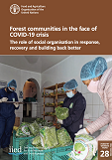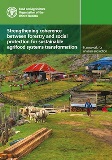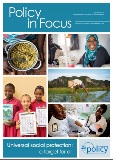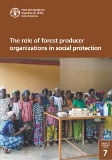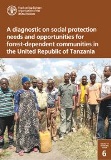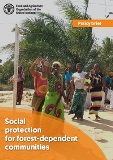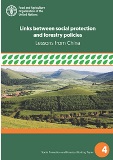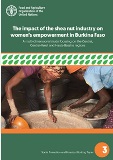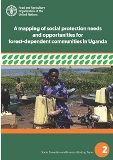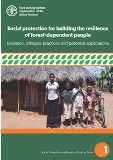
Social protection and forestry
Social protection is a set of policies and programmes designed to help reduce and prevent poverty and vulnerability, and ensure income security. Most food insecure and poor people with the greatest need for social protection live in rural areas and depend on natural resources – including forests – for their livelihoods. Forests serve as a safety net in times of crisis and increase the resilience of forest communities. However, forest-dependent communities are also vulnerable to ecological degradation and climate change, and are often in remote and disconnected rural areas characterized by low levels of market development and poor access to public goods and social services.
Social protection involves three pillars:
- Social assistance: alleviating chronic or transient poverty through non-contributory programmes, which are publicly provided, for most vulnerable individuals or households with limited other means of adequate support that can be provided in-kind or in cash.
- Social insurance: mitigating risks associated with poor health, old age, pregnancy (and post-natal care), unemployment, work injury and disability. Social insurance is derived from contributory schemes with part funding coming from the state.
- Labour market protection: creating employment and promoting livelihoods through generated economic opportunities, improved quality of employment and protects workers through improved working conditions, as well as training and skills development that target unemployed and underemployed rural workers.
FAO works to:
- expand the coverage of social protection to forest-dependent communities, households and forest workers
- strengthen the coherence between forestry and social protection policies and programmes
- improve the role of rural forest producer organizations in social protection
- promote decent forestry employment opportunities




Social organization key to future crisis response for forest communities – FAO report

©FAO
Rome – A new report assesses the impact of COVID-19 on forest communities and highlights the vital role of social organization in their response, recovery and in building back better after the pandemic.
Launched by the Food and Agriculture Organization of the United Nations (FAO), Forest communities in the face of COVID-19 crisis – The role of social organization in response, recovery and building back better explains that COVID-19 exacerbated existing vulnerabilities and created new challenges. But many forest communities have proven to be resilient, according to the working paper.
“These communities have mobilised through locally accountable organizations. They have been able to use their trusted social capital to assess and respond to the needs of their members and local communities, often faster and better than state institutions,” said Ewald Rametsteiner, Deputy Director of FAO’s Forestry Division.
The report provides an understanding of the individual and collective responses to the COVID-19 crisis and identifies key pathways and strategic actions for forest communities to recover and build back better, drawing on data from reported COVID-19 impacts, case studies from forest and farm producer organizations in five countries and lessons learnt from previous crises.
Disproportionate impact on vulnerable communities
The impact of COVID-19 on health, education and livelihoods in these communities has been, and continues to be, severe and higher than for many other communities, the report says.
Mistrust of the state means that these communities have accessed vaccines less. At the same time, domestic violence and mental health problems have increased, while access to health services has become even more limited. With online education unavailable, children, especially girls, from low-income families have been most affected. Incomes from forest tourism have disappeared and markets for forest products have become more volatile.
At the same time, COVID-19 has seen an increase in urban-rural migration pushing up local demand for food as well as a wave of deforestation and illegal extraction of forest goods. In some countries external illegal loggers used the pandemic as an opportunity to expand activities , ignoring environmental regulations protecting forest communities.
Solutions through collective action
Key responses led by forest farm producer organizations and Indigenous Peoples’ organizations, have included the use of informal and formal social protection systems, increasing the harvesting of wild foods and creating new employment opportunities. At the same time, advocacy groups on behalf of these historically marginalized communities have lobbied for information, policy representation and support such as food aid and purchasing and distribution of surplus food by the state.
The report recommends strengthening organizations representing forest communities so they can work to address longstanding injustices and inequalities as part of the concept of building back better. Strong organizations representing forest communities can ensure social protection, good dissemination of information and public schemes to provide employment.
Their advocacy can secure better access to healthcare, defend territorial rights and where necessary force states to protect and support Indigenous Peoples through legal action. Reviving traditional practices like harvesting and preparing wild foods and traditional production methods can also allow communities to be more resilient to shocks.
The role of forest communities in the world
The report points out that ensuring these communities recover and are not disproportionately affected by future crises is vital to the wider world. Globally smallholder production systems, many of which are located in forested landscapes, are the main source of food for more than 70% of the world’s people. They underpin global food security.
Many of these organizations also play a critical role in achieving climate change mitigation and adaptation goals through their management of forest areas. In addition, territories managed by Indigenous Peoples contain a considerable part of the world’s remaining biodiversity. Sharing the lessons from the COVID-19 pandemic will help recovery and developing better resilience for the next crisis.
Related publication
Publications
Events
22/ 7
2020
Social protection for forest-dependent communities: Building on the response to the COVID-19 pandemic for more resilient forest livelihoods
Virtual Event, 22/07/2020
Increasing knowledge on the role and opportunities of social protection in the COVID-19 response and to support recovery for forest-dependent communities.
5/ 6
2019
6/6
2019
Expert meeting to discuss the draft guiding framework for strengthening coherence between forestry and social protection for forest-dependent communities
Rome (Italy), 05/06/2019 - 06/06/2019
The objective of the expert meeting is to provide technical comments and inputs to the draft guiding framework for strengthening coherence between forestry and social protection for forest-dependent communities. FAO Forestry Division is developing this guiding framework in cooperation with the UNU-MERIT.
19/ 7
2018
Creating synergies between forestry and social protection
Rome (Italy), 19/07/2018
Since 2016, FAO has worked to expand the coverage of social protection measures to forest-dependent communities and to strengthen coherence between forestry and social protection.

